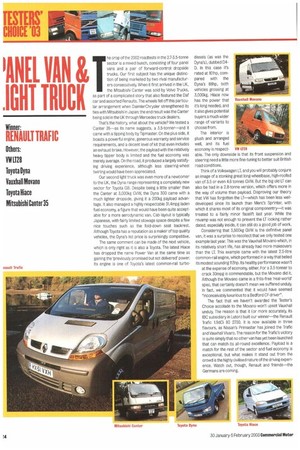' I A G L VAN &
Page 24

If you've noticed an error in this article please click here to report it so we can fix it.
. I TRUCK
Winner:
RENAULT TRIFIC
Others: Toyota Dyna Vauxhall Movano Toyota Hiace Mitsubishi Canter 35
he crop of the 2002 roadtests in the 2.7-3.5-tonne sector is a mixed bunch, consisting of four panel vans and a pair of forward-control dropside trucks. Our first subject has the unique distinc tion of being marketed by two rival manufactur ers consecutively. When it first arrived in the UK, the Mitsubishi Canter was sold by Volvo Trucks, as part of a complicated story that also featured the Daf car and assorted Renaults. The wheels fell off this particular arrangement when DaimlerChrysler strengthened its ties with Mitsubishi in Japan: the end result was the Canter being sold in the UK through Mercedes truck dealers.
That's the history, what about the vehicle? We tested a Canter 35—as its name suggests, a 3.5-tonner—and it came with a tipping body by Tipmaster. On the plus side, it boasts a powerful engine, generous warranty and service requirements, and a decent level of kit that even includes an exhaust brake. However, the payload with the relatively heavy tipper body is limited and the fuel economy was merely average. On the road, it produced a largely satisfying driving experience, although less steering-wheel twirling would have been appreciated.
Our second light truck was even more of a newcomer to the UK, the Dyna range representing a completely new sector for Toyota GB. Despite being a little smaller than the Canter at 3,000kg GVW, the Dyne 300 came with a much lighter dropside, giving it a 200kg payload advantage. It also managed a highly respectable 31.4mpg laden fuel economy, a figure that would have been quite acceptable for a more aerodynamic van. Cab layout is typically Japanese, with fairly limited stowage space despite a few nice touches such as the fold-down seat backrest. Although Toyota has a reputation as a maker of top quality vehicles, the Dyna's list price is surprisingly competitive.
The same comment can be made of the next vehicle, which is only right as it is also a Toyota. The latest Niece has dropped the name Power Van at the same time as gaining the 'previously promised but not delivered' power. Its engine is one of Toyota's latest common-rail turbo
diesels (as was the Dyne's), dubbed D4D. In this case it's rated at 101hp, compared with the Dyna's 88hp, both vehicles grossing at 3,000kg. Niece now has the power that it's long needed, and it also gives potential buyers a much wider range of variants to choose from.
The interior is plush and arranged well, and its fuel economy is respectVYi LT28
able. The only downside is that its front suspension and steering need a little more fine-tuning to better suit British road conditions.
Think of a Volkswagen LT, and you will probably conjure an image of a stonking great long-wheelbase, high-roofed van of 3.5 or even 4.6 tonnes GVW. But the big old LT can also be had in a 2.8-tonne version, which offers more in the way of volume than payload. Disproving our theory that VW has forgotten the LT—which has been less welldeveloped since its launch than Merc's Sprinter, with which it shares most of its original componentry—it was treated to a fairly minor facelift last year. While the revamp was not enough to prevent the LT looking rather dated, especially inside, it can still do a good job of work.
Considering that 3,500kg GVW is the definitive panel van, it was a surprise to recollect that we only tested one example last year. This was the Vauxhall Movano which, in its relatively short life, has already had more makeovers than the LT. This example came with the latest 2.5-litre common-rail engine, which performed in a way that belied its modest sounding 113hp. Its healthy performance wasn't at the expense of economy, either. For a 3.5-tonner to crack 30mpg is commendable, but the Movano did it Although the Movano came in a frills-free 'real-world' spec, that certainly doesn't mean we suffered unduly.
In fact, we commented that it would have seemed "inconceivably luxurious to a Bedford CF driver".
The fact that we haven't awarded the Tester's Choice accolade to the Movano won't upset Vauxhall unduly. The reason is that it (or more accurately, its IBC subsidiary in Luton) built our winner—the Renault Trafic 1.9dCi 80 2700. It is now available in three flavours, as Nissan's Primastar has joined the Trafic and Vauxhall Vivaro. The reason for the Trafic's victory is quite simply that no other van has yet been launched that can match its all-round excellence. Payload is a match for the rest of the sector and fuel economy is exceptional, but what makes it stand out from the crowd is the highly civilised nature of the driving experience. Watch out, though, Renault and friends—the Germans are coming.




























































































































































